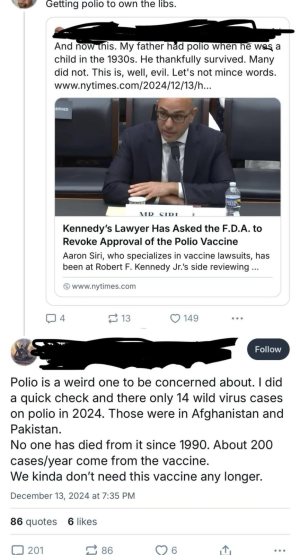New England Journal of Medicine Dr. Fauci
he latest threat to global health is the ongoing outbreak of the respiratory disease that was recently given the name Coronavirus Disease 2019 (Covid-19). Covid-19 was recognized in December 2019.
1 It was rapidly shown to be caused by a novel coronavirus that is structurally related to the virus that causes severe acute respiratory syndrome (SARS). As in two preceding instances of emergence of coronavirus disease in the past 18 years
2 — SARS (2002 and 2003) and Middle East respiratory syndrome (MERS) (2012 to the present) — the Covid-19 outbreak has posed critical challenges for the public health, research, and medical communities.
In their
Journal article, Li and colleagues
3 provide a detailed clinical and epidemiologic description of the first 425 cases reported in the epicenter of the outbreak: the city of Wuhan in Hubei province, China. Although this information is critical in informing the appropriate response to this outbreak, as the authors point out, the study faces the limitation associated with reporting in real time the evolution of an emerging pathogen in its earliest stages. Nonetheless, a degree of clarity is emerging from this report. The median age of the patients was 59 years, with higher morbidity and mortality among the elderly and among those with coexisting conditions (similar to the situation with influenza); 56% of the patients were male. Of note, there were no cases in children younger than 15 years of age. Either children are less likely to become infected, which would have important epidemiologic implications, or their symptoms were so mild that their infection escaped detection, which has implications for the size of the denominator of total community infections.
On the basis of a case definition requiring a diagnosis of pneumonia, the currently reported case fatality rate is approximately 2%.
4 In another article in the
Journal, Guan et al.
5 report mortality of 1.4% among 1099 patients with laboratory-confirmed Covid-19; these patients had a wide spectrum of disease severity. If one assumes that the number of asymptomatic or minimally symptomatic cases is several times as high as the number of reported cases, the case fatality rate may be considerably less than 1%. This suggests that the overall clinical consequences of Covid-19 may ultimately be more akin to those of a severe seasonal influenza (which has a case fatality rate of approximately 0.1%) or a pandemic influenza (similar to those in 1957 and 196

rather than a disease similar to SARS or MERS, which have had case fatality rates of 9 to 10% and 36%, respectively.
2
The efficiency of transmission for any respiratory virus has important implications for containment and mitigation strategies. The current study indicates an estimated basic reproduction number (R0) of 2.2, which means that, on average, each infected person spreads the infection to an additional two persons. As the authors note, until this number falls below 1.0, it is likely that the outbreak will continue to spread. Recent reports of high titers of virus in the oropharynx early in the course of disease arouse concern about increased infectivity during the period of minimal symptoms.
6,7
China, the United States, and several other countries have instituted temporary restrictions on travel with an eye toward slowing the spread of this new disease within China and throughout the rest of the world. The United States has seen a dramatic reduction in the number of travelers from China, especially from Hubei province. At least on a temporary basis, such restrictions may have helped slow the spread of the virus: whereas 78,191 laboratory-confirmed cases had been identified in China as of February 26, 2020, a total of 2918 cases had been confirmed in 37 other countries or territories.
4 As of February 26, 2020, there had been 14 cases detected in the United States involving travel to China or close contacts with travelers, 3 cases among U.S. citizens repatriated from China, and 42 cases among U.S. passengers repatriated from a cruise ship where the infection had spread.
8 However, given the efficiency of transmission as indicated in the current report, we should be prepared for Covid-19 to gain a foothold throughout the world, including in the United States. Community spread in the United States could require a shift from containment to mitigation strategies such as social distancing in order to reduce transmission. Such strategies could include isolating ill persons (including voluntary isolation at home), school closures, and telecommuting where possible.
9
A robust research effort is currently under way to develop a vaccine against Covid-19.
10 We anticipate that the first candidates will enter phase 1 trials by early spring. Therapy currently consists of supportive care while a variety of investigational approaches are being explored.
11 Among these are the antiviral medication lopinavir–ritonavir, interferon-1β, the RNA polymerase inhibitor remdesivir, chloroquine, and a variety of traditional Chinese medicine products.
11 Once available, intravenous hyperimmune globulin from recovered persons and monoclonal antibodies may be attractive candidates to study in early intervention. Critical to moving the field forward, even in the context of an outbreak, is ensuring that investigational products are evaluated in scientifically and ethically sound studies.
12
Every outbreak provides an opportunity to gain important information, some of which is associated with a limited window of opportunity. For example, Li et al. report a mean interval of 9.1 to 12.5 days between the onset of illness and hospitalization. This finding of a delay in the progression to serious disease may be telling us something important about the pathogenesis of this new virus and may provide a unique window of opportunity for intervention. Achieving a better understanding of the pathogenesis of this disease will be invaluable in navigating our responses in this uncharted arena. Furthermore, genomic studies could delineate host factors that predispose persons to acquisition of infection and disease progression.
The Covid-19 outbreak is a stark reminder of the ongoing challenge of emerging and reemerging infectious pathogens and the need for constant surveillance, prompt diagnosis, and robust research to understand the basic biology of new organisms and our susceptibilities to them, as well as to develop effective countermeasures.






 rather than a disease similar to SARS or MERS, which have had case fatality rates of 9 to 10% and 36%, respectively.
rather than a disease similar to SARS or MERS, which have had case fatality rates of 9 to 10% and 36%, respectively.

































